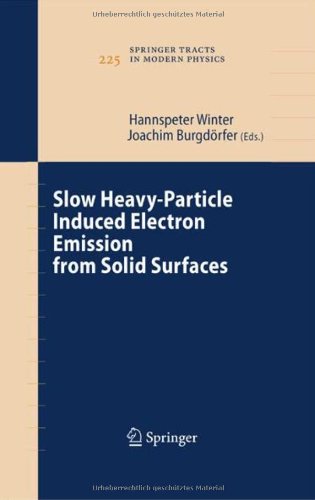Slow Heavy Particle Induced Electron Emission from Solid Surfaces 1st Edition by Hannspeter Winter, Joachim Burgdorfer ISBN 3642089712 9783642089718 by Winter H., Burgdoerfer J. (eds.) 9783540707882, 3540707883 instant download after payment.
Slow Heavy Particle Induced Electron Emission from Solid Surfaces 1st Edition by Hannspeter Winter, Joachim Burgdorfer - Ebook PDF Instant Download/Delivery: 3642089712, 9783642089718
Full download Slow Heavy Particle Induced Electron Emission from Solid Surfaces 1st Edition after payment

Product details:
ISBN 10: 3642089712
ISBN 13: 9783642089718
Author: Hannspeter Winter, Joachim Burgdorfer
Inthepastfewdecades,greatprogresshasbeenmadeinthe?eldofdynamical interactions of photons and charged particles with surfaces. Developments in this ?eld have largely been driven by technological advances. Foremost, the preparation and characterization of atomically ?at surfaces has opened up opportunities to precisely and reproducibly investigate surface structure and dynamics in unprecedented detail. An equally important advance represents the availability of new sources for projectiles interacting with and probing surfaces. Third-generation s- chrotron sources provide high-brilliance photon ?ux over a broad range of energies extending from the ultraviolet to the hard X-ray regime. In the c- text of the primary topics of this book of even greater importance is the development of ion sources that provide slow, very highly charged ions with signi?cant intensities covering charge states up to bare uranium. Currently pursueddevelopment projects suchas HITRAP(highly charged trapped ions) atGSIDarmstadtholdthepromisetodeliverwithinthenextfewyearscooled highly charged ions in the sub-eV kinetic energy regime. These advances in experimental techniques have led to an increased - cus on technological applications. Prominent examples include the controlled nanostructuring of surfaces for novel functionalities on the sub-micron scale and the search of surface materials suited for divertor surfaces in future th- monuclear fusion reactors, in particular to control and reduce physical and chemical sputtering. Concurrently, theory has made great strides. The und- standing and solution of the many-body problem beyond the ground state, which is at the core of the description of dynamical surface processes, has considerably advanced.
Slow Heavy Particle Induced Electron Emission from Solid Surfaces 1st Table of contents:
Part I: Fundamental Concepts and Background
- Chapter 1: Introduction to Particle-Solid Interaction
- Basic concepts of ion-solid interaction
- Energy loss mechanisms of slow heavy particles in solids
- Overview of various emission phenomena (sputtering, photon emission, electron emission)
- Chapter 2: Electron Emission from Solids
- Work function and electron affinity
- Band structure effects on electron emission
- Types of electron emission (photoelectric, thermionic, field, secondary electron emission)
- Historical overview of heavy-particle induced electron emission (PIEE)
Part II: Mechanisms of Slow Heavy-Particle Induced Electron Emission
- Chapter 3: Potential Electron Emission (PE)
- Quantum mechanical tunneling of electrons
- Resonance neutralization and Auger neutralization
- Dependence on projectile charge state and work function
- Experimental techniques for studying PE
- Chapter 4: Kinetic Electron Emission (KE)
- Mechanism of electron promotion and cascade generation
- Role of projectile and target electronic structure
- Threshold energies for KE
- Modeling KE: Firsov model, statistical models
- Chapter 5: Interplay and Transition Between PE and KE
- The velocity dependence of electron emission
- Regimes of dominant PE vs. KE
- Transition region and complex emission processes
Part III: Experimental Techniques and Instrumentation
- Chapter 6: Ion Beam Production and Handling
- Ion sources for heavy particles
- Beam transport and focusing
- Charge state selection and control
- Chapter 7: Ultra-High Vacuum (UHV) Systems and Surface Preparation
- Requirements for clean surfaces
- Surface characterization techniques (LEED, Auger, XPS)
- Chapter 8: Electron Detection and Energy Analysis
- Electron spectrometers (Cylindrical Mirror Analyzer, Hemispherical Analyzer)
- Electron multipliers and detectors
- Time-of-flight techniques
- Chapter 9: Data Acquisition and Analysis
- Statistical considerations in electron counting
- Correction for detector efficiency and background noise
Part IV: Experimental Results and Theoretical Models
- Chapter 10: Electron Emission from Metals
- Dependence on projectile type, energy, and angle of incidence
- Influence of surface conditions (oxidation, contamination)
- Comparison with theoretical predictions
- Chapter 11: Electron Emission from Semiconductors and Insulators
- Differences in emission mechanisms compared to metals
- Charging effects and their mitigation
- Specific material responses
- Chapter 12: Electron Emission from Nanostructures and Thin Films
- Size and quantum confinement effects
- Enhanced emission from nanostructured surfaces
- Applications in nano-characterization
- Chapter 13: Role of Projectile Charge Exchange and Excited States
- Neutralization and reionization processes near the surface
- Contribution of excited projectile states to electron emission
- Chapter 14: Advanced Theoretical Models and Simulations
- First-principles calculations of electron emission
- Molecular dynamics and Monte Carlo simulations
- Many-body effects in electron-solid interaction
Part V: Applications and Future Directions
- Chapter 15: Applications of PIEE
- Surface analysis and characterization
- Detectors for slow ions
- Plasma diagnostics
- Materials processing and modification
- Chapter 16: Future Outlook and Open Questions
- Challenges in theoretical modeling
- New experimental avenues
- Emerging applications
People also search for Slow Heavy Particle Induced Electron Emission from Solid Surfaces 1st:
slowing down electrons
slow moving particles
slow particle
slow down particles blender
a slow process
Tags: Hannspeter Winter, Joachim Burgdorfer, Particle, Electron



